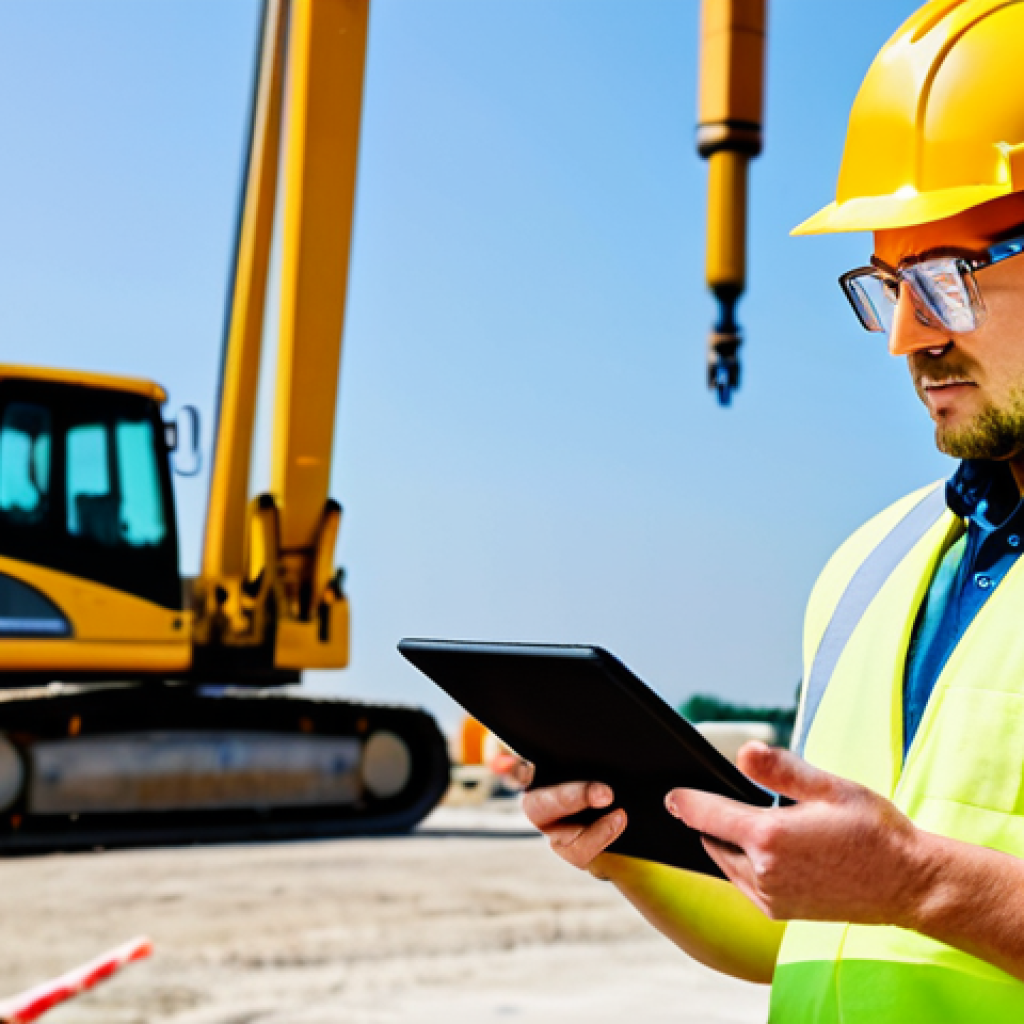Walking past any major construction site, it’s hard not to feel the sheer scale of the work, but often, the silent heroes ensuring everyone goes home safe are overlooked.
I’ve personally witnessed how a seemingly minor oversight can lead to catastrophic consequences, cementing my belief that the role of a dedicated construction safety professional is absolutely indispensable.
It’s no longer just about ticking boxes; with increasingly stringent regulations, the rising cost of accidents, and a global push towards ESG principles, the demand for highly competent construction safety engineers has exploded.
From my perspective, this isn’t just a job; it’s a critical lifeline for any project. Companies are realizing that investing in top-tier safety expertise isn’t an expense, but a vital investment that protects human lives, safeguards multi-million dollar projects, and preserves corporate reputations.
With emerging technologies like AI-powered risk assessment and drone inspections becoming commonplace, the role is evolving, demanding a new level of foresight and adaptability.
The market is unequivocally hungry for individuals who can navigate complex regulations, implement innovative safety protocols, and most importantly, foster a true culture of safety on-site.
Let’s delve into the details now.
The Shifting Sands of Construction Site Dynamics

When I first stepped onto a construction site years ago, I vividly remember the chaos that sometimes felt inherent to the process. It was a symphony of heavy machinery, shouting, and a pervasive sense of urgency.
Back then, safety often felt like an afterthought, a regulatory hurdle to be cleared rather than an integral part of the operation. But times, thankfully, have changed dramatically.
Today, the sheer complexity of modern construction, coupled with an increased public and legal accountability, has transformed the role of safety from a mere administrative task into a crucial strategic imperative.
Companies are no longer just building structures; they’re building legacies, and that includes a legacy of safety. The push for green building, smarter infrastructure, and even space-constrained urban projects introduces new layers of risk that traditional safety models simply can’t address.
Navigating Enhanced Regulatory Frameworks
The regulatory landscape has become an intricate maze, evolving with startling rapidity. What was once a relatively straightforward set of OSHA guidelines has expanded to include highly specific local ordinances, environmental protections, and even international standards for larger multinational projects.
I’ve seen firsthand how a company, well-intentioned but perhaps not fully up-to-date, can stumble into massive fines and project delays simply by misinterpreting a nuanced clause.
A skilled construction safety professional isn’t just aware of these rules; they understand the *spirit* behind them, predicting future shifts and proactively implementing preventative measures.
It’s about foreseeing the next regulatory wave and ensuring the entire team is ready to surf it, not get drowned by it.
Embracing Holistic Risk Management
True safety in construction goes far beyond hard hats and safety vests. It encompasses an exhaustive, holistic approach to risk management that considers everything from psychological well-being to supply chain vulnerabilities.
Think about the cumulative stress on workers in a high-pressure environment, or the domino effect of a delayed material shipment leading to rushed, unsafe workarounds.
I recall a project where a seemingly minor issue with material storage compounded, leading to multiple near-misses before a proper risk assessment identified the systemic flaw.
Modern safety leadership demands looking at the entire ecosystem of a project, identifying latent dangers, and creating robust mitigation strategies that cover the human, environmental, and logistical elements.
The Undeniable ROI of Proactive Safety Investment
For far too long, safety was incorrectly viewed as a cost center, a necessary evil that chipped away at profit margins. This perspective, born from a short-sighted financial model, completely misses the immense return on investment (ROI) that robust safety programs deliver.
I’ve personally seen balance sheets crippled by the aftermath of a preventable accident – the legal fees, the skyrocketing insurance premiums, the loss of skilled labor, and perhaps most damaging, the irreparable damage to a company’s reputation.
When a company experiences a major safety incident, the ripple effects can last for years, impacting future bids and talent acquisition. In today’s competitive landscape, safety is not just good ethics; it’s smart business.
Minimizing Direct and Indirect Accident Costs
Let’s talk numbers, because that’s what often gets attention in boardrooms. The direct costs of an accident are obvious: medical expenses, workers’ compensation, and property damage.
But it’s the indirect costs that are truly staggering and often hidden. Think about lost productivity from interrupted work, investigation time, increased administrative burdens, retraining replacement workers, and the potential for regulatory fines.
I remember one incident where a crane collapse not only caused millions in direct damage but led to a four-month project delay, costing the company tens of millions in contractual penalties and lost revenue.
A well-placed safety engineer, through preventative measures and rigorous training, effectively acts as a shield against these devastating financial losses.
They’re not just preventing injuries; they’re safeguarding the bottom line.
Enhancing Corporate Reputation and Employee Morale
Beyond the immediate financial impact, safety performance profoundly influences a company’s standing in the industry and its ability to attract and retain top talent.
In an era where ESG (Environmental, Social, and Governance) principles are gaining unprecedented importance, a strong safety record is a powerful differentiator.
Companies that prioritize worker well-being are seen as more responsible, ethical, and trustworthy. I’ve spoken with countless construction professionals who explicitly seek out employers with exemplary safety records, knowing that a safe workplace translates to job security and peace of mind.
High morale, driven by a feeling of being valued and protected, directly correlates with increased productivity and reduced turnover, creating a virtuous cycle of success.
Cultivating a Resilient Safety Culture
It’s one thing to have a safety manual; it’s an entirely different beast to embed safety into the very DNA of an organization. This isn’t just about rules and regulations; it’s about changing mindsets, fostering open communication, and empowering every single individual on a site to be a safety advocate.
From my experience, the true measure of a safety culture isn’t when things go right, but how a team responds when an unexpected challenge arises. Does everyone instinctively prioritize safety, or do they cut corners?
This shift requires persistent, empathetic leadership and a deep understanding of human behavior.
Fostering Employee Engagement and Buy-In
The most effective safety programs are those where workers feel a sense of ownership, not just compliance. This means moving beyond top-down mandates to a collaborative approach where frontline employees are actively involved in identifying hazards, suggesting improvements, and developing solutions.
I’ve found that when workers feel heard and their insights are genuinely valued, they become the strongest proponents of safety. Simple initiatives like anonymous suggestion boxes, regular “toolbox talks” where real-life experiences are shared, and peer-to-peer safety observations can dramatically transform the collective consciousness.
It’s about building a community where looking out for one another isn’t just a policy, but a deeply ingrained habit.
Implementing Continuous Improvement Loops
A safety culture is never static; it’s a living, breathing entity that requires constant nurturing and adaptation. This means establishing robust feedback mechanisms, conducting thorough incident investigations (not just to assign blame, but to learn), and regularly reviewing protocols to ensure their efficacy.
I once worked with a company that implemented a brilliant “lessons learned” debrief after every near-miss, no matter how minor. This created a culture of transparency and continuous learning, transforming potential hazards into valuable training opportunities.
It’s about being agile, responsive, and relentlessly committed to getting better every single day.
The Essential Skillset of the Modern Safety Leader
The role of a construction safety professional has evolved light-years beyond simply inspecting equipment and filling out forms. Today’s safety leader is a multi-faceted individual, blending technical expertise with strong interpersonal and strategic capabilities.
They are educators, negotiators, innovators, and sometimes, even impromptu therapists in high-stress situations. The demand for a truly comprehensive skill set is higher than ever, and frankly, it’s what differentiates the good from the truly indispensable.
Mastering Technical Competence and Regulatory Acumen
At the core, a safety professional must possess an unshakeable grasp of safety principles, engineering controls, and the ever-expanding universe of relevant regulations.
This includes everything from fall protection systems and scaffolding design to confined space entry procedures and hazardous material handling. But it’s not enough to simply know the rules; they must understand *why* those rules exist and how to apply them effectively in diverse, often unpredictable construction environments.
This often involves detailed risk assessments, developing emergency response plans, and ensuring all machinery and tools meet stringent safety standards.
Without this fundamental technical bedrock, all other efforts can crumble.
Developing Exceptional Communication and Leadership Abilities
This is where the “human” element truly shines. A safety professional must be an exceptional communicator, capable of conveying complex information clearly and concisely to diverse audiences – from seasoned superintendents to brand-new laborers.
They need to be persuasive without being preachy, firm yet empathetic, and capable of diffusing tension while maintaining authority. I’ve seen the most technically brilliant safety plans fail simply because they weren’t communicated effectively or because the safety officer lacked the leadership presence to inspire compliance.
It requires a nuanced understanding of human psychology, the ability to build rapport, and the courage to sometimes deliver difficult messages.
Embracing Technological Savvy and Data Analytics
The construction industry is rapidly adopting new technologies, and safety professionals are at the forefront of this revolution. From drone inspections that identify hidden hazards to AI-powered predictive analytics that flag high-risk activities before they occur, technology is reshaping how safety is managed.
A modern safety leader needs to be tech-savvy, comfortable with data analysis, and open to integrating innovative tools into their daily workflow. This isn’t just about using software; it’s about leveraging data to identify patterns, measure performance, and continuously refine safety strategies, making decisions based on insights rather than intuition alone.
| Aspect of Safety Role | Traditional Approach | Modern Approach (Driven by Safety Professionals) |
|---|---|---|
| Primary Focus | Compliance & Reactivity (Post-Incident) | Prevention & Proactivity (Pre-Incident) |
| Technology Use | Basic tools, paper forms | IoT sensors, drones, AI analytics, BIM for safety planning |
| Cultural Emphasis | “Blame Game” after incidents | Shared responsibility, continuous learning, empowerment |
| Cost Perception | Cost center, necessary evil | Investment with significant ROI, competitive advantage |
| Skillset Required | Rules knowledge, inspection ability | Technical expertise, leadership, communication, data analysis |
Navigating Pathways to a Fulfilling Safety Career
So, you’re intrigued by the pivotal role of a construction safety professional and considering diving into this dynamic field? Excellent choice! The path is not always linear, but it is incredibly rewarding.
From my perspective, it’s a career built on continuous learning and a genuine passion for safeguarding lives and projects. There are multiple entry points and opportunities for growth, making it an accessible yet highly specialized profession.
The demand for qualified individuals means that investing in your education and certifications will almost certainly yield significant returns.
Essential Education and Certifications
While some entry-level positions might accept a high school diploma with relevant experience, the most sought-after roles typically require a bachelor’s degree in occupational safety and health, engineering, or a related field.
However, it’s the certifications that truly set you apart. Credentials like the Certified Safety Professional (CSP), Associate Safety Professional (ASP), and Construction Health and Safety Technician (CHST) are highly respected and often a prerequisite for senior positions.
I can tell you from experience that earning these certifications isn’t just about having letters after your name; the process itself forces a deep dive into complex safety principles that are invaluable on the job.
Pursuing further education, like a Master’s in Safety Management, can also open doors to executive-level roles and specialized consulting.
Gaining Practical Experience and Mentorship
Education provides the theoretical framework, but real-world experience is where you truly hone your skills. Starting in an entry-level safety role, perhaps as a safety coordinator or an assistant, allows you to gain hands-on experience with site inspections, incident investigations, and safety training.
Seek out mentors – seasoned professionals who can share their wisdom, guide you through challenging situations, and help you navigate the nuances of the industry.
I personally benefited immensely from working under an experienced safety director who taught me not just the “what,” but the “why” and “how” of effective safety leadership.
These formative years are crucial for developing the confidence and practical acumen needed to excel.
The Transformative Impact on Project Success and Well-being
At the end of the day, what truly matters in construction safety is the tangible impact on human lives and the successful realization of complex projects.
It’s a field where your contributions are not just about compliance, but about creating environments where people can thrive, build, and return home safely to their families every single day.
This isn’t abstract; it’s deeply personal and profoundly important. When you see a project completed on time, within budget, and, most importantly, without a single serious incident, you feel a deep sense of accomplishment that few other professions can offer.
Ensuring Human Safety and Protecting Lives
This is, without a doubt, the most profound aspect of the role. Every day, a construction safety professional acts as a guardian, implementing measures that directly prevent injuries, disabilities, and even fatalities.
I remember standing on a massive bridge construction site, looking down at the hundreds of workers below, and realizing the immense responsibility resting on the safety team’s shoulders.
It’s a weight, yes, but it’s also an incredible privilege. Knowing that your diligence and foresight have sent someone home healthy and whole is an incomparable feeling.
It’s about more than just numbers; it’s about the human element, the families waiting, the lives preserved.
Driving Operational Efficiency and Project Delivery
A safe site is inherently an efficient site. When workers feel secure, they are more focused, more productive, and less prone to costly errors. Accidents lead to delays, investigations, repairs, and a significant drain on resources.
Conversely, a well-managed safety program minimizes these disruptions, ensuring that projects stay on schedule and within budget. It’s a clear demonstration of how prioritizing human well-being directly contributes to the bottom line.
From my own observations, teams that embrace a strong safety culture often outperform their less safety-conscious counterparts in every metric that matters, proving that safety is not just a moral imperative, but a powerful accelerant for project success.
Concluding Thoughts
Stepping back and looking at the vast, intricate world of construction, it becomes undeniably clear that the role of a safety professional is not just ancillary but absolutely central to every successful project.
From the early days of chaotic sites to today’s highly regulated and technically advanced environments, I’ve personally witnessed the profound transformation.
It’s about more than regulations; it’s about safeguarding human lives, protecting investments, and building a legacy of excellence. For anyone considering this path, know that you’re choosing a career where your vigilance directly translates to well-being and prosperity, a truly rewarding endeavor.
Useful Information
1. OSHA Compliance is Paramount: In the United States, adherence to Occupational Safety and Health Administration (OSHA) standards is non-negotiable. Familiarize yourself thoroughly with these regulations, as they form the bedrock of construction safety. Neglecting them can lead to severe penalties and, more importantly, avoidable accidents.
2. Professional Organizations Offer Resources: Joining groups like the National Safety Council (NSC) or the American Society of Safety Professionals (ASSP) can provide invaluable networking opportunities, continuing education, and access to the latest industry best practices and research. I’ve found these communities to be instrumental for growth.
3. Technology Adoption is Key: Modern safety involves leveraging tools like drones for aerial inspections, wearable tech for real-time monitoring of vitals or proximity alerts, and advanced data analytics platforms to predict potential hazards. Staying abreast of these innovations will make you an indispensable asset.
4. Focus on Near-Miss Reporting: Encourage a culture where near-misses are reported and investigated without blame. These incidents are invaluable learning opportunities that can prevent major accidents down the line. I’ve seen firsthand how a robust near-miss program can drastically improve site safety over time.
5. Prioritize Mental Health: The construction industry can be high-stress. A comprehensive safety program should also address the psychological well-being of workers, offering resources and fostering an open environment where stress and mental health concerns can be discussed. A healthy mind contributes to a safer worker.
Key Takeaways
Construction safety has evolved from a regulatory burden to a strategic imperative, driven by complex projects and increased accountability. Proactive safety investments yield significant ROI by minimizing direct and indirect accident costs, and enhancing corporate reputation and employee morale.
Cultivating a resilient safety culture involves fostering employee engagement, buy-in, and implementing continuous improvement loops. Modern safety leaders require a blend of technical competence, strong communication and leadership abilities, and technological savvy.
Ultimately, a robust safety program ensures human safety and protects lives, while simultaneously driving operational efficiency and project delivery, making it a cornerstone of successful construction.
Frequently Asked Questions (FAQ) 📖
Q: Beyond the stacks of regulations and technical specs, what’s truly the most critical skill for a construction safety professional to master in today’s demanding environment?
A: Oh, man, if I had a dollar for every time someone just pointed to a rulebook, I’d be retired on a beach somewhere! The absolute game-changer, the thing that separates the truly indispensable pros from the box-tickers, is their ability to foster a real safety culture.
It’s not about being the “safety cop” who just barks orders; it’s about being a trusted advisor, a mentor, even a bit of a psychologist. I’ve been on sites where you had seasoned veterans, proud of their old-school ways, resisting even the simplest new protocol.
My approach? Instead of quoting OSHA regs at them, I’d sit down, listen to their concerns, and often, share a story – maybe about a near-miss I saw, or worse, a tragic accident that could have been avoided with a simple precaution.
It’s about building rapport, showing you genuinely care about them going home to their families. When they believe you’re looking out for them, not just for the company’s liability, that’s when the entire dynamic shifts.
You can have all the certifications in the world, but if you can’t connect with the crew, if you can’t inspire that collective sense of responsibility, you’re just a glorified clipboard holder.
That human touch? Priceless.
Q: Everyone’s buzzing about
A: I and drones. How are these cutting-edge technologies really changing the daily grind for construction safety engineers on the ground? A2: It’s fascinating, honestly.
For anyone picturing robots taking over, let me tell you, it’s nothing like that! These tools aren’t replacing us; they’re supercharging our capabilities.
I mean, think about it: instead of spending hours manually inspecting every single scaffold joint or elevated platform, a drone can capture high-resolution imagery and video in minutes, flagging potential issues we might have missed with the naked eye from the ground.
And AI? It’s phenomenal for predictive analysis. We’re talking about systems that can analyze mountains of historical data – weather patterns, incident reports, equipment maintenance logs – to highlight specific areas or tasks with a higher risk profile before anything even happens.
I’ve seen this in action, where AI flagged a particular type of repetitive strain injury risk based on site layout and work patterns, prompting us to adjust workflows and prevent actual injuries.
It doesn’t mean we’re glued to screens all day; it means we’re freed up to do what really matters: hands-on engagement, training, and fostering that safety culture.
The technology just gives us sharper eyes and a smarter brain to work with. It’s a force multiplier, plain and simple.
Q: From a purely business standpoint, beyond the moral obligation, what’s the tangible, dollar-and-cents argument for companies to really invest top dollar in construction safety expertise?
A: Alright, let’s talk brass tacks, because this is where the rubber meets the road for execs. Yes, saving lives is paramount, but for the balance sheet, it boils down to mitigating catastrophic financial risk.
I’ve seen companies get absolutely crippled by a single, avoidable accident. We’re talking millions in fines from regulatory bodies like OSHA, multi-million dollar lawsuits from injured workers or their families – and believe me, those legal battles drag on, bleeding resources.
Then there’s the skyrocketing insurance premiums; one major incident can send those through the roof for years. But it’s not just the direct costs. Think about project delays: a serious accident can shut down a site for days, sometimes weeks, while investigations are underway.
Every single day of delay costs astronomical sums in lost productivity, extended equipment rentals, and missed deadlines, often incurring penalties. And the hit to reputation?
Priceless, in a bad way. No one wants to partner with a company known for cutting corners on safety. Conversely, a stellar safety record attracts top talent, builds client trust, and can even lower your borrowing costs because you’re seen as a less risky venture.
It’s not an expense; it’s an investment that pays dividends, sometimes literally saving a company from going under. It’s like buying premium insurance for your entire operation.
📚 References
Wikipedia Encyclopedia
구글 검색 결과
구글 검색 결과
구글 검색 결과
구글 검색 결과
구글 검색 결과





